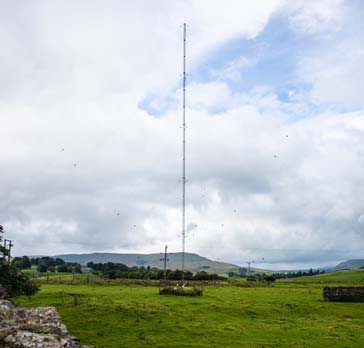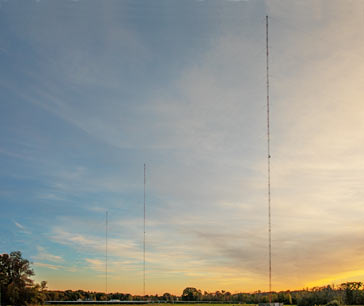What is a Vertical Antenna: Vertical Aerial Types
Vertical antennas are used in many radio applications from mobile communications to point to point radio communications, private radio communications,, broadcasting, etc
Home » Antennas & Propagation » this page
Vertical antennas includes:
Types of vertical antenna
Quarter wavelength vertical
5λ/8 vertical
J pole
Vertical antennas form a widely used form of radio antenna. Used in a number of specific areas, their properties enable them to provide performance that horizontal or other antennas are unable to provide.
There are several different flavours or types of vertical antenna that can be used from LF to HF, VHF and beyond.
The properties of these antennas mean that they can operate in a specific way which can be used to good effect in many different applications for two way radio communications, broadcasting and for many other functions.

What is a vertical antenna
It is probably worth first defining what a vertical antenna to give a basic understanding of the concept of a vertical antenna.
Vertical antenna definition:
a vertical antenna is one where the main element or elements of the antenna are vertically orientated and the polarisation of the transmitted radio wave is also vertically polarised.
Whilst vertical antennas are all vertically orientated, there are many different variants.
Not only does their size change according to the frequency in use, but also their method of mounting may change as well.
Vertical antenna properties
The properties and advantages of vertical antennas enable them to be used in a variety of different areas.
Although vertical antennas may not be ideal for all situations, understanding their advantages means that they can be used to advantage where their properties are most suited.
Some of the vertical antenna properties and advantages include:
Omnidirectional radiation pattern: Single element vertical antennas exhibit an omnidirectional radiation pattern in the horizontal plane. This means that the signal will spread out equally in all directions.
The omni-directional capability is ideal where all around coverage is required, and it is one of the reasons why vertical antennas are used for many point to point mobile radio communications. As the vehicle moves, the vertical antenna at the base station will not need to re-orientate their antenna. So too on the vehicle where it will be changing its direction, the all around radiation and reception is essential.
Vertically polarised radiation: Having a vertical element, or elements, these antennas radiate vertically polarised signals. This is an advantage when the signal is being received by other vertically polarised antennas. If the antennas are, what is termed, cross polarised, then in theory no signal would be received.
In practice there will always be some change in the polarisation of the signal caused by reflections and other aspects of radio propagation, so some signal is still likely to be received.
Propagation considerations: Vertically polarised radiation has some advantages for lower frequency propagation modes. For example ground wave propagation, used for LF and some MF transmissions is often better when a vertically polarised antenna is used. Studies have shown that the signal propagate with less attenuation when they are vertically polarised.
For HF the propagation modes mean that signals of either polarisation may be used. There are some studies that indicate that horizontally polarised low angle radiation is better for long distance communications if the antenna can provide a sufficiently low angle of radiation, i.e. a vertical antenna may produce more low angle radiation, but horizontally polarised radiation may on some occasions provide better results.
Provides low angle of radiation: The signal that emanates from a vertical antenna tends to have a low angle of radiation, i.e. the maximum levels of signal radiation are closer t being parallel with the Earth's surface. Accordingly there is less at higher angles, i.e. directed towards the sky, and more that can be received by other terrestrial stations.
It also has advantages for long distance ionospheric communications where a low angle of radiation will assist in gaining additional distance. Some vertical antennas are designed to increase the low angle radiation, further reducing the level at higher angles and thereby providing additional gain over a vertical dipole or quarter wave vertical.
Space occupied: The space occupied by a vertical antenna is normally less than that occupied by an equivalent horizontally polarised antenna. If just the space for the vertical itself is considered, then much less 'real estate' is required for a vertical.
However for monopole antennas like those needing a ground connection or a ground plane for elevated operation, the space used by this must also be considered. Sometimes the grounding system will use buried radials extending out a fair distance. Although the ground can still be used for other purposes if these buried radials are used, the ground must still be available for this.
Ease of mounting: Vertical antenna types are normally easy to mount, requiring a single mounting at the base. Many vertical antennas can require a simple bracket or pole to enable them to be mounted somewhere.
Windage: In some instances the wind resistance of a vertical antenna may be less than that of a horizontally mounted equivalent. Figures need to be checked for each instance.

Grounding vertical antennas
Many vertical antennas are what are termed monopole antennas and require the use of a ground for their proper operation.
In fact for these monopoles the grounding system or the ground plane is an integral part of the antenna.
When selecting an antenna system for whatever purpose: mobile two way radio communications, amateur radio, broadcasting or whatever, consideration should be given to the type of antenna and whether it needs a grounding system of some form.
The ground can implemented in one of two main ways:
- Physical earth connection: The most obvious method is to make a physical connection to the earth using ground rods and the like.
Action of RF ground with a monopole antenna
Note on antenna RF grounding:
Grounding an antenna can be key to its operation, particularly if it is a vertical monopole antenna where the ground forms part of the antenna.
Read more about antenna RF ground.
- Ground plane system: It is also possible to simulate a ground system using what is termed a ground plane. This is often made up from a number of typically quarter wavelength radials.
Vertical antenna with ground plane radials
Note on antenna ground plane:
Apart from using a direct connection to ground, it is also possible to use a 'simulated' ground consisting of a conducting plate or a number of radials. The advantage of this scheme is that it can be raised above the real ground to improve the coverage.
Read more about antenna ground plane.
Vertical antenna types
There are many different types of vertical antenna that have been designed and are in common use. Some of the more popular are mentioned below:
Quarter wave vertical: The quarter wave vertical antenna type is one of the most popular forms of vertical antenna. It is easy to construct, it can be made to be very robust and provides a good level of performance. This form of antenna requires the use of a connection to ground (connection as short as possible), or a ground plane. This increases the space required and windage of the antenna.
Five eighths wave vertical: This form of vertical antenna is popular in many instances because it is able to provide gain over a quarter wave vertical, focussing more power in a plane closer to the horizontal. As such it is used in many applications. Like the basic quarter wave vertical, this antenna also needs a ground plane against which to operate.
J pole antenna : This type of vertical antenna is a convenient for of vertical antenna. It provides some gain over a quarter wave vertical and has the advantage that it does not require any radials or some form of ground plane against which to operate.
Vertical dipole: The vertical dipole is used in some instances to provide a robust form of vertical antenna. It has the advantage that it does not require any radials, but does require to be a minimum of a half wavelength long.
Vertical antennas are able to operate particularly well in many instances. Utilising their advantages means that the best can be made of what they have to offer, but against this the disadvantages should also be considered as well.
 Written by Ian Poole .
Written by Ian Poole .
Experienced electronics engineer and author.
More Antenna & Propagation Topics:
EM waves
Radio propagation
Ionospheric propagation
Ground wave
Meteor scatter
Tropospheric propagation
Antenna basics
Cubical quad
Dipole
Discone
Ferrite rod
Log periodic antenna
Parabolic reflector antenna
Phased array antennas
Vertical antennas
Yagi
Antenna grounding
Installation guidelines
TV antennas
Coax cable
Waveguide
VSWR
Antenna baluns
MIMO
Return to Antennas & Propagation menu . . .





